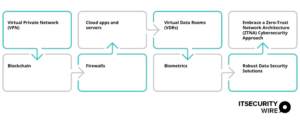All organizations, regardless of industry, type, or size, are prone to cyberattacks. Full-blown cyberattacks or data breaches can cripple business operations. It has become crucial for business leaders to apply strong cybersecurity measures.
This security approach helps businesses to improve their immunity against cyber threats.
Hence, cybersecurity leaders need to have fool-proof defense mechanism. They must It allocate skilled resources efficiently to ensure zero security gaps.
Applying a resilient cybersecurity strategy ensures that the resources are clear on their functions. In this article, let’s explore the ways to reduce the gaps in cybersecurity defense mechanisms.
Designing a resilient cybersecurity attack strategy needs a data-driven approach.
Strategies to Develop a Resilient Cybersecurity Posture
Following are a few ways that CISOs can develop a fool-proof security approach:
1. Proactive Cybersecurity Measures
Proactive cybersecurity measures are an effective defense mechanism. To stay secure against sophisticated threats, security leaders need to adopt an strong defense mechanism.
No organization can overlook this critical step if they want to develop a resilient cybersecurity posture.
2. Data Segmentation
Every data set stored on the business network does not have the same value. Businesses can segment their data considering its value to their organization.
Data segmentation is a crucial step in developing a strong cybersecurity approach. Following are a few aspects that businesses can consider to classify data:
-
Highly Restricted Sensitive Data
Businesses should identify highly sensitive data that hackers are usually looking out for. It is crucial to Identify sensitive data sets as per privacy regulations.
Malicious actors usually seek intellectual property (IP), customer, or workforce information. It is essential to segregate sensitive data and separate it from all the other data.
This is one of the smartest approaches to developing a resilient cybersecurity strategy. In addition, being careful about who, where, and when has access to this sensitive information, is crucial.
-
Less Sensitive Data
Decision-makers should identify and share less sensitive data based on need. For instance, if a new resource joins the project, they should have access to the sensitive data. Businesses need to revoke access to the data as soon as the person leaves the project. It is crucial to detect such data sets and take necessary actions to secure the data.
-
Public Domain Data
Data that is accessible to all in the public domain, is always at risk.
Data segmentation plays a crucial role in developing resilient security to secure data. Once businesses segment this data, decision-makers can decide who can access it. Isolating the sensitive data sets will help to strengthen security.
3. Employee training
Any organization is as secure as its weakest link. Internal threats, intentional or not, can expose the organization to significant threats. Hence, employee training plays a crucial role in developing a resilient cybersecurity.
Decision-makers must imparts cybersecurity training program to educate the resources across the organization.
Technologies Available to Develop Resilient Cybersecurity Posture

-
Virtual Private Network (VPN)
VPN is one of the most preferred secured networks for hybrid workers. It provides secure access via encryption or a secure data tunnel.
Virtual private networks enable organizations to secure the IP address. It is an effective tool for organizations with a globally dispersed workforce.
However, one important thing to consider is that, not all VPNs are the same. A few virtual private networks do not have encryption capabilities. For instance, the Point-to-Point Tunneling Protocol (PPTP) does not allow encryption.
SecOps teams will have to use secondary protocols to allow encryption. Instead, business security leaders should select VPNs that have encryption capabilities. CISOs can consider Secure Shell (SSH), Secure Sockets Layer (SSL), or Transport Layer Security (TLS) for their choice of VPN.
-
Blockchain
Decentralization is the core of Blockchain technology. It uses encryption and verification to add/remove blocks.
Blockchain technology developed on distributed ledger systems is the most effective tool to reduce gaps in cybersecurity. It is one of the most difficult systems for a hacker to crack. Hence, a distributed ledger is the most preferred way to secure sensitive information.
One of the significant benefits of Blockchains is that they have a strong defense system. As a result, it is a better option to embrace for resilient cybersecurity defense.
Despite the immense benefits, not all businesses use Blockchain to develop resilient cybersecurity.
-
Firewalls
Firewalls play a crucial role as a data safety checkpoint. They are an effective tool for developing a resilient cybersecurity posture. This tool will be a data safety touchpoint when users access or share data from anywhere.
-
Cloud apps and servers
Cloud-based applications require credentials to access the systems. Additionally, in the cloud, any particular device does not store cloud apps and servers.
Hence, even if organizations lose out on a particular system, their data will still be secure.
These applications let the users access the information based on data segmentation and access granted. A few cloud vendors offer resilient cybersecurity defense solutions to their cloud servers and applications.
-
Virtual Data Rooms (VDRs)
Enterprises that execute the most crucial business transactions online need VDRs. Organizations that conduct meetings with clients negotiate and close deals online; for them, VDR is a must.
-
Biometrics
Many security leaders overlook the importance of biometrics in cybersecurity. Resources are accessing sensitive business information from any device and from anywhere. This is a big risk.
It is crucial to embrace biometrics on the tech stack to develop a resilient cybersecurity posture.
Businesses can validate the users before they access sensitive data. Embracing biometrics tools will allow businesses to monitor each device accessing the business network.
-
Robust Data Security Solutions
Various data security vendors offer solutions like encryption, tokenization, protection, and masking services. Business leaders must select the vendors that facilitate data security, even when it has left the system. The top data security solutions will secure data even when accessed on other systems.
Also Read: Leading Machine Learning Applications in Cybersecurity
-
Embrace a Zero-Trust Network Architecture (ZTNA) Cybersecurity Approach
Zero-trust network architecture (ZTNA) is one of the best approaches to ensure resilient cybersecurity. This mechanism verifies all the users or devices before allowing access. ZTNA does not trust any user or devices, even if they are registered on the network. Such security does not leave gaps, resulting in a resilient cybersecurity posture.
These are the technologies and ways that CISOs can consider to develop a resilient cybersecurity posture.
For more such updates follow us on Google News ITsecuritywire News. Please subscribe to our Newsletter for more updates.









